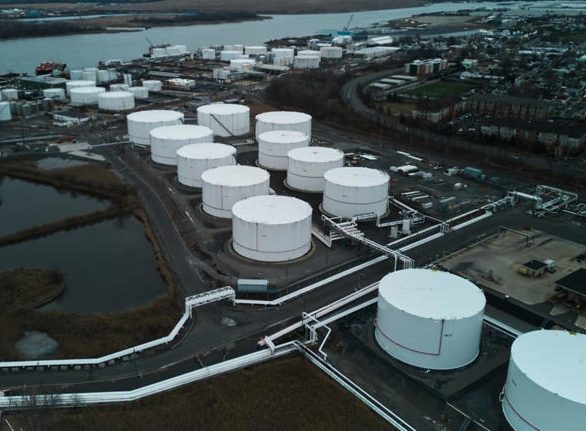
The AI Boom Is Powering Gas-Pipeline Stocks
Pipeline stocks have been the best-performing segment of the energy industry in the past month, outperforming oil producers, refiners, and even big players such as Exxon Mobil.
One reason appears to be the rise of artificial intelligence, and the need for natural gas to power the data centers that run AI programs. Pipelines that transmit that gas are in a good position to benefit. Some analysts and investors think it’s a theme that will lift the stocks for longer.
Shares of leading natural-gas-pipeline company Kinder Morgan are on a 13-day winning streak, their longest on record, and could extend the streak after rising 0.2% in early trading on Tuesday. The stock has risen 9.1% in that time period, and is up 13% this year. Other pipeline operators have seen similar strong performance recently, following first-quarter results. Williams stock is up 7.8% in the past month, while Enbridge shares are up 4.2%, and Oneok stock is up 4.1%. Refiners and oil-producer stocks are down on average over the past month.
On their latest earnings calls, all those pipeline companies spoke about the rising electricity demand from data centers that process AI applications. Before last month, the term “data center” had seldom been uttered by pipeline executives on earnings calls, according to data company AlphaSense.
Natural gas is the largest source of electricity generation in the U.S., and electricity demand is set to grow in the coming years after more than a decade of stagnation. Analysts believe that demand from data centers in particular could double or triple in the next five years, putting stress on the transmission grid. Some utilities say they will need more natural-gas power plants to supply the necessary electricity, and that could increase demand for pipelines to send that gas to the plants. Similar trends have lifted other kinds of energy stocks, from nuclear operators such as Constellation Energy to renewable companies such as Brookfield Renewable Partners.
The AI data center trend is a “timely zeitgeist” that is boosting sentiment for natural-gas pipelines, wrote Mizuho analyst Gabriel Moreen in a recent note. The actual manifestation of that demand hasn’t come yet, but Moreen believes expectations of future demand are helping boost long-dated natural-gas futures. While spot prices of natural gas today trade at $2.75 per million British Thermal Units, futures expiring in January 2026 are trading at $4.51 per million BTUs.
Some operators of pipelines and natural-gas-storage facilities, which are collectively known as “midstream companies,” say they are already hearing from customers about the need for more natural gas.
“We have already had conversations with several of our large electric-power-generation customers and power developers, who anticipate the need for additional natural gas transportation to address this future AI data center-related power demand,” said Oneok CEO Pierce Norton II on the company’s earnings conference call earlier this month.
The data-center trend comes at an important moment for midstream companies. Low natural-gas prices over the winter had hurt some of the stocks, and delays in construction of natural-gas export facilities were also weighing on sentiment, analysts say. Midstream stocks have trailed most oil and gas stocks since the pandemic. While Exxon Mobil stock has risen above its 2019 levels and hit new record highs this year, most midstream operators remain below their prepandemic highs.
The biggest reason is that most investors bought the midstream stocks for their dividends, and some of the companies cut those dividends during the pandemic or during a previous energy downturn five years before.
In an interview, Tortoise Capital Advisors portfolio manager Rob Thummel said that the companies have restored investor confidence by strengthening their balance sheets.
“They started by lowering debt, and then have gradually increased dividends, and buyback programs have been instituted,” he said in an interview. Kinder Morgan, for instsance, has a dividend yield of 5.8%. The stock is now a traditional corporation, instead of a master limited partnership (MLP) like it used to be—some investors didn’t like the MLP structure because it can make tax accounting more complicated. Other pipeline operators have made similar changes in the past few years.
Tortoise runs an exchange-traded fund called the Tortoise North American Pipeline Fund that’s up 11% this year.
Thummel believes that the stocks have room to run from here. Data centers and natural-gas exports will lift natural-gas demand to at least 130 billion cubic feet per day by 2030, up from about 104 BCF/day last year, Tortoise projects. The U.S. has a limited number of pipelines, and operators often struggle to get proposed pipelines approved. So pipelines have become a valuable scarce asset.
“The regulatory environment is so difficult, that I think that makes the value of existing pipelines worth even more,” Thummel said.
